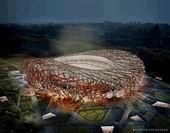|
Beauty and Waste in the Architecture of
Herzog & de Meuron
22 Ocak - 08 Mayıs 2005, Netherlands Architecture Institute, Rotterdam -
Hollanda |
 'An architecture exhibition consisting of waste' is how Jacques Herzog, one
half of the Swiss architectural duo Herzog & de Meuron, describes the exhibition
that will take place in Gallery 1 of the NAI. The bits of 'waste' are the
by-product of the design process: material studies, sketches and models. They
allow us a glimpse of the ideas behind finished and world-renowned buildings
such as the Tate Modern in London and the Domus Winery in California. In
addition to the 'waste,' the exhibition will also show the beauty of Herzog & de
Meuron's buildings through art works, some of them commissioned especially for
the exhibition, by artists who are friends and collaborators of the architects. 'An architecture exhibition consisting of waste' is how Jacques Herzog, one
half of the Swiss architectural duo Herzog & de Meuron, describes the exhibition
that will take place in Gallery 1 of the NAI. The bits of 'waste' are the
by-product of the design process: material studies, sketches and models. They
allow us a glimpse of the ideas behind finished and world-renowned buildings
such as the Tate Modern in London and the Domus Winery in California. In
addition to the 'waste,' the exhibition will also show the beauty of Herzog & de
Meuron's buildings through art works, some of them commissioned especially for
the exhibition, by artists who are friends and collaborators of the architects.
Pritzker Prize
Although Herzog & de Meuron are relatively unknown in the Netherlands, in
the rest of the world they are ranked alongside Frank Gehry and Rem Koolhaas.
They have worked all over the world, from the USA to Europe and Asia. In 2001
they received the Pritzker Prize - architecture's Nobel Prize - for their entire
oeuvre. Their most celebrated design is the Tate Modern (1994-2000) in London, a
power station that they have turned into a museum for modern and contemporary
art. The practice has recently completed another building in London - the Laban
Dance Centre - for which they won the prestigious Stirling Prize. Other notable
designs include the Olympic Stadium in Beijing, the de Young and Walker Art
Museum's in the United States, the headquarters for Ricola in Mulhouse, the
Prada store in Tokyo and the Domus Winery in the Napa Valley in California.
A glimpse inside the studio
The exhibition, which was first shown in Schaulager in Basel, provides a
behind-the-scenes view of Herzog & de Meuron's studio from its first commissions
25 years ago to its most recent large-scale projects. The various stages in the
design process, comprising hundreds of objects utilizing a variety of materials
and techniques, will be displayed on tables. In addition to models there will be
many material samples on exhibit to help to illustrate the design process. They
are, according to Herzog: "Silent witnesses of the intellectual, dynamic group
process that sometimes leads to buildings." They are the by-products, leftovers
and traces of a thought process designed to take the project to the next step or
to convince the client. An example of such a thought process was an experiment
in the Schaulager with the raw materials for Ricola candy, with which they
modeled an entire landscape.
Master planning
In addition, sketches, images and master planning projects in China on which
Herzog & de Meuron are currently working will be displayed in individual
pavilions. The sketches on paper napkins and scraps of paper show that, in
addition to working with computers, Herzog & de Meuron use traditional
techniques and carry on the design process at all times and in any place. The
sketches are viewed by Herzog & de Meuron as works of art and as such are
exhibited and sold.
Film stills
The images comprise photographs and films stills of Herzog & de Meuron
buildings by artists such as Remy Zaugg, Thomas Ruff and Andreas Gursky. The
master planning projects, as well as student work displayed in a separate
pavilion, will complete the survey by showing the implication of Herzog & de
Meuron's work for the larger scale of the city and the region, as well as its
translation into other means and other places. In this manner, the exhibition
will exhibit the full range of Herzog & de Meuron's imaginative reworking of our
reality in process, product and provocative speculation.
Web:
http://www.nai.nl/e/calendar/activities/hdm_e.html
|
|